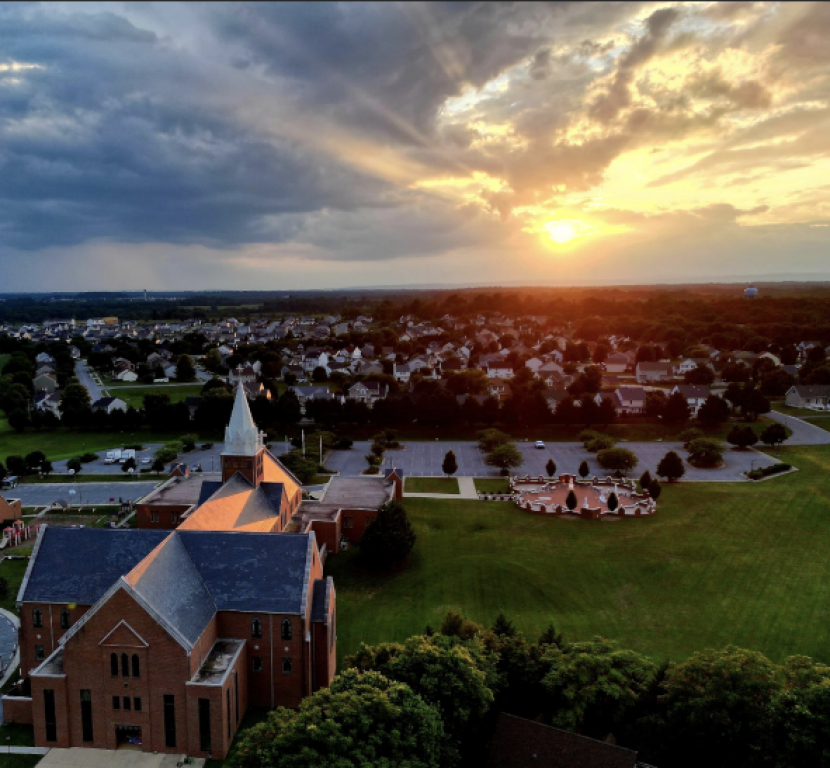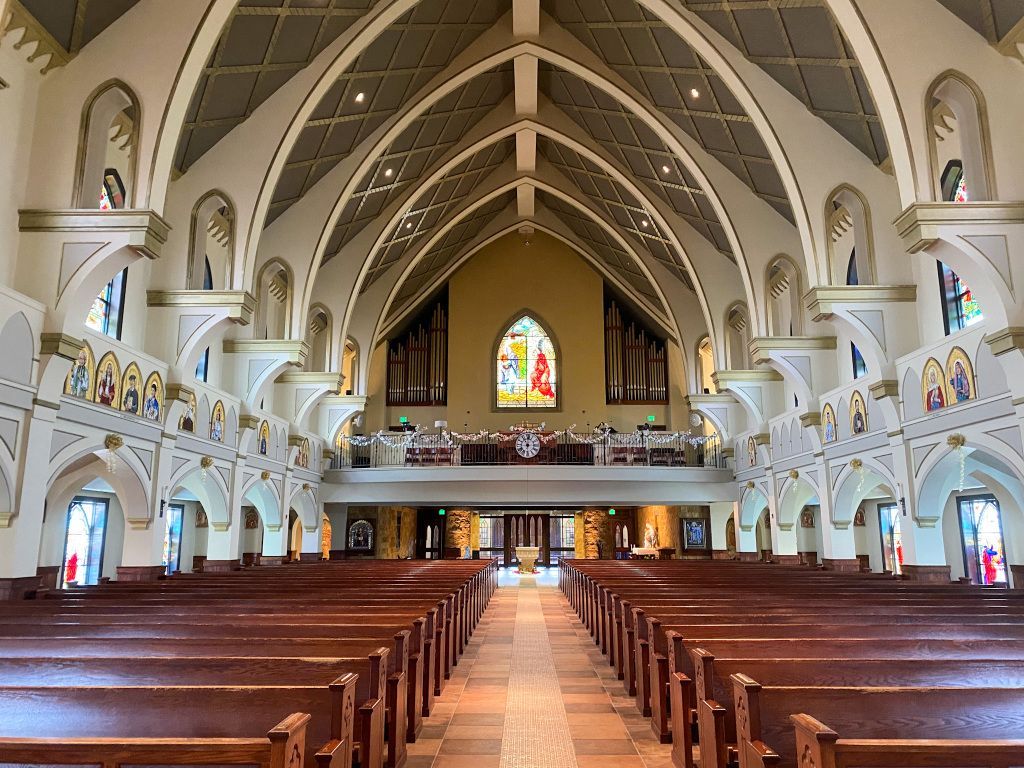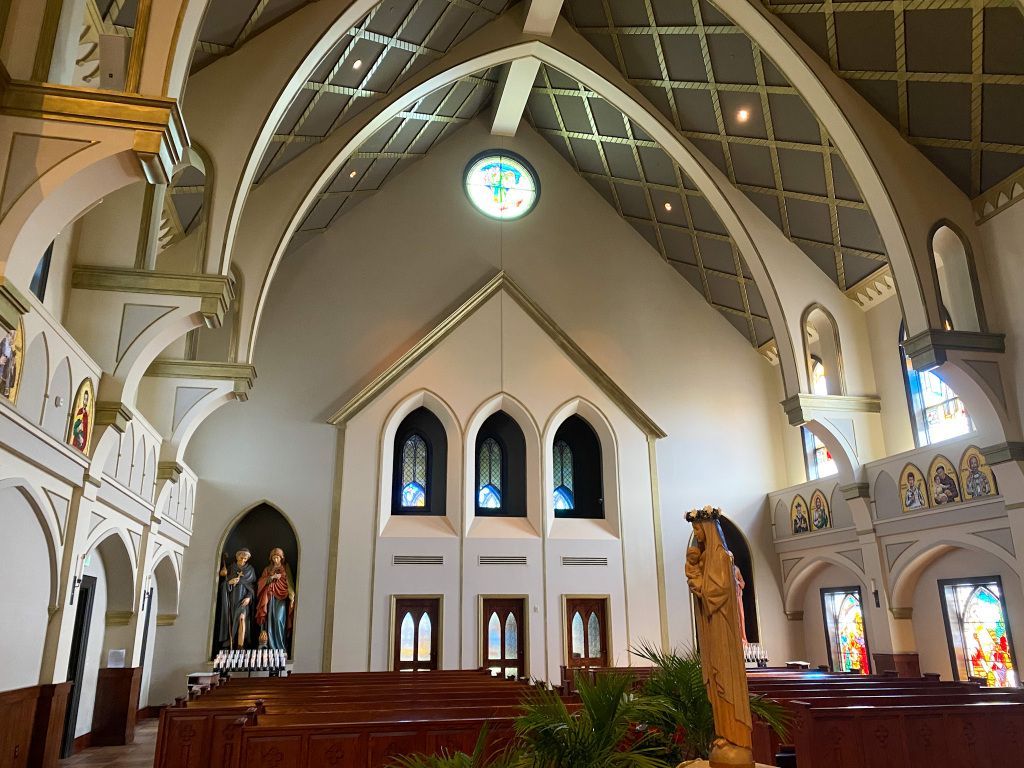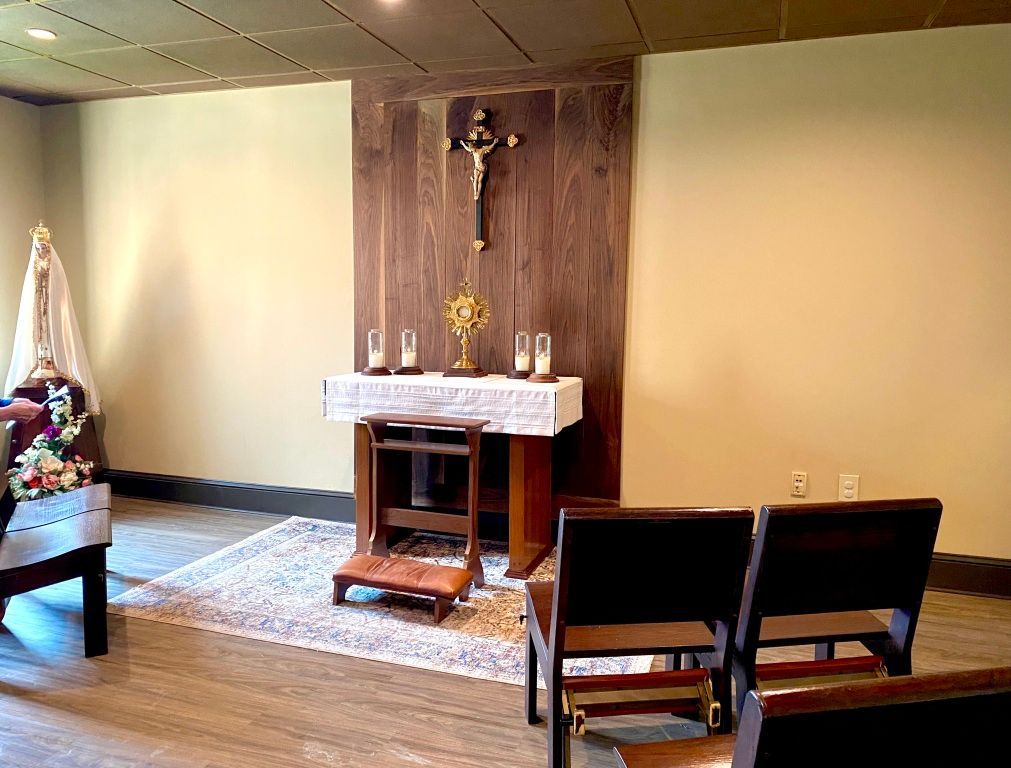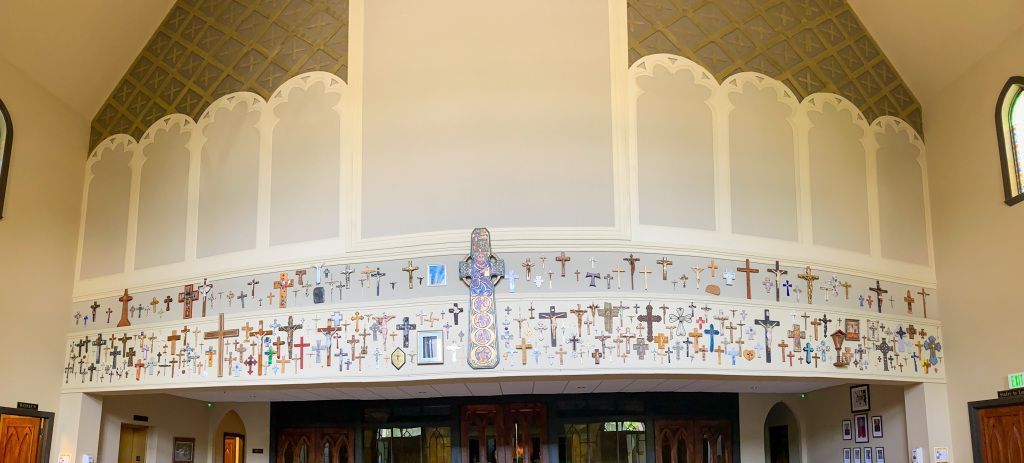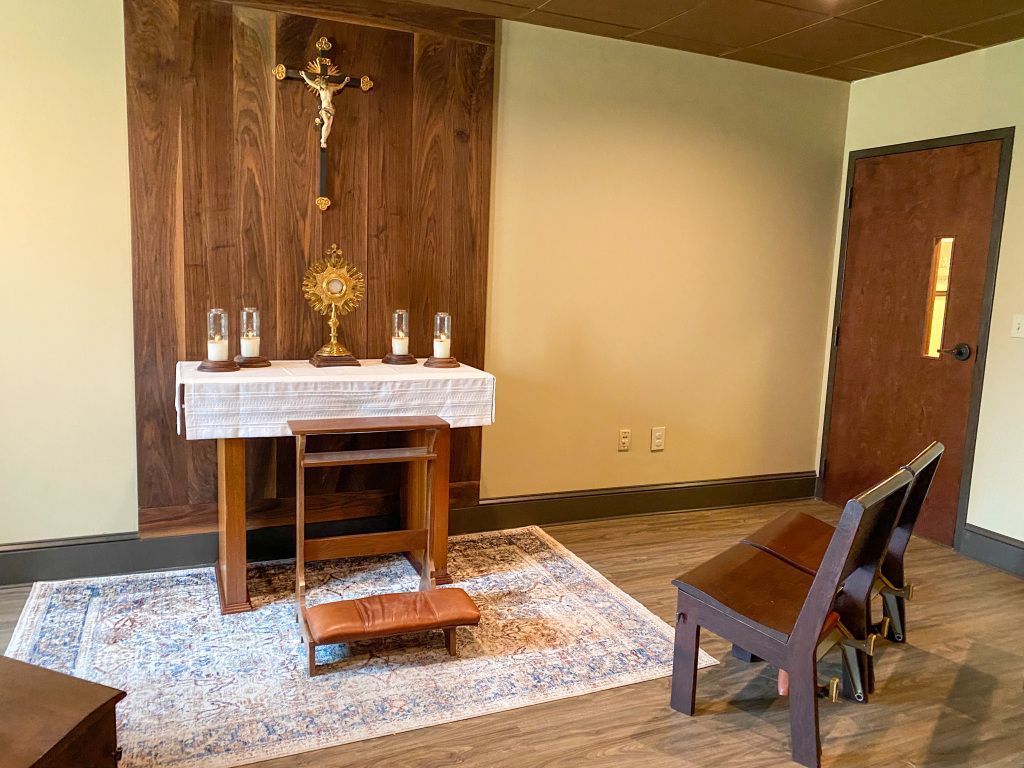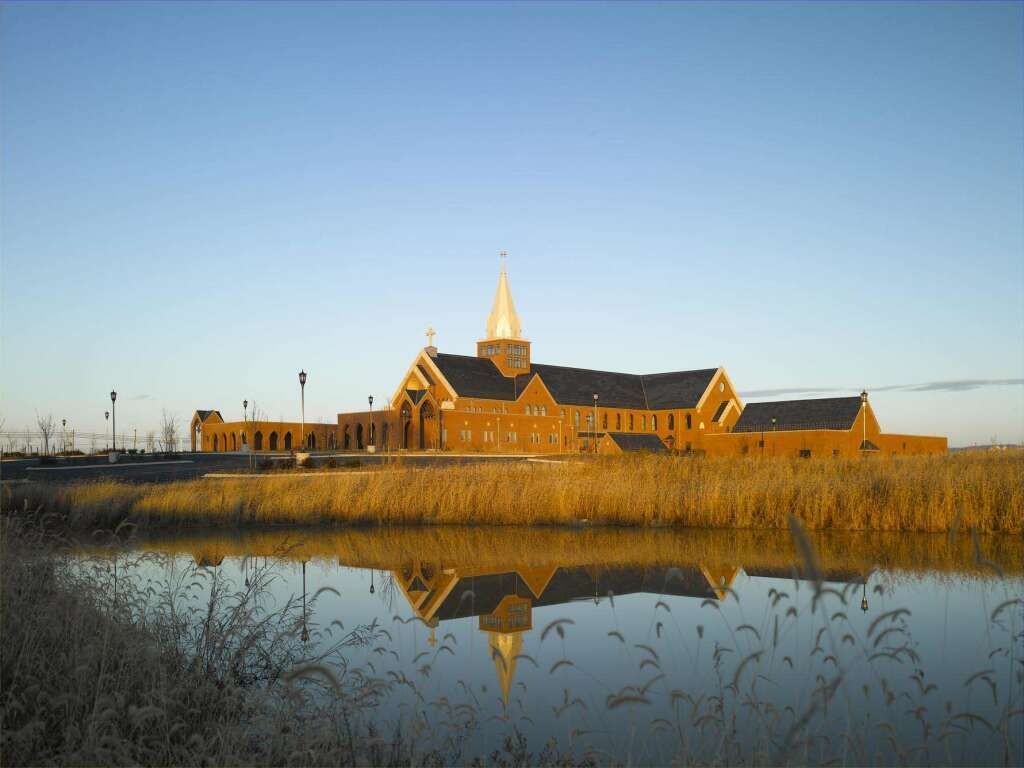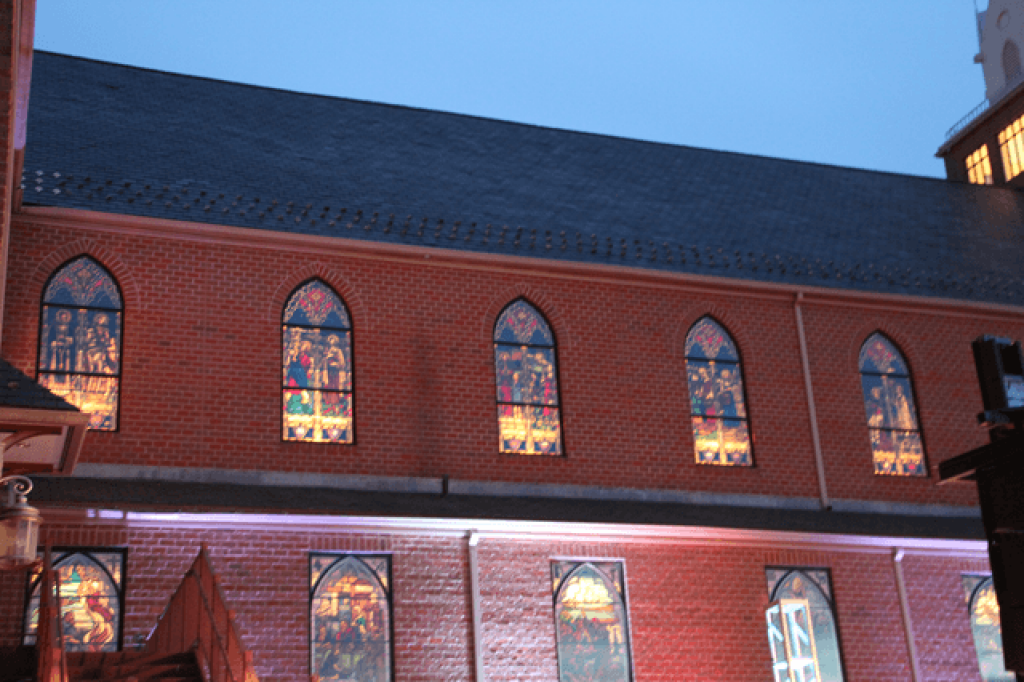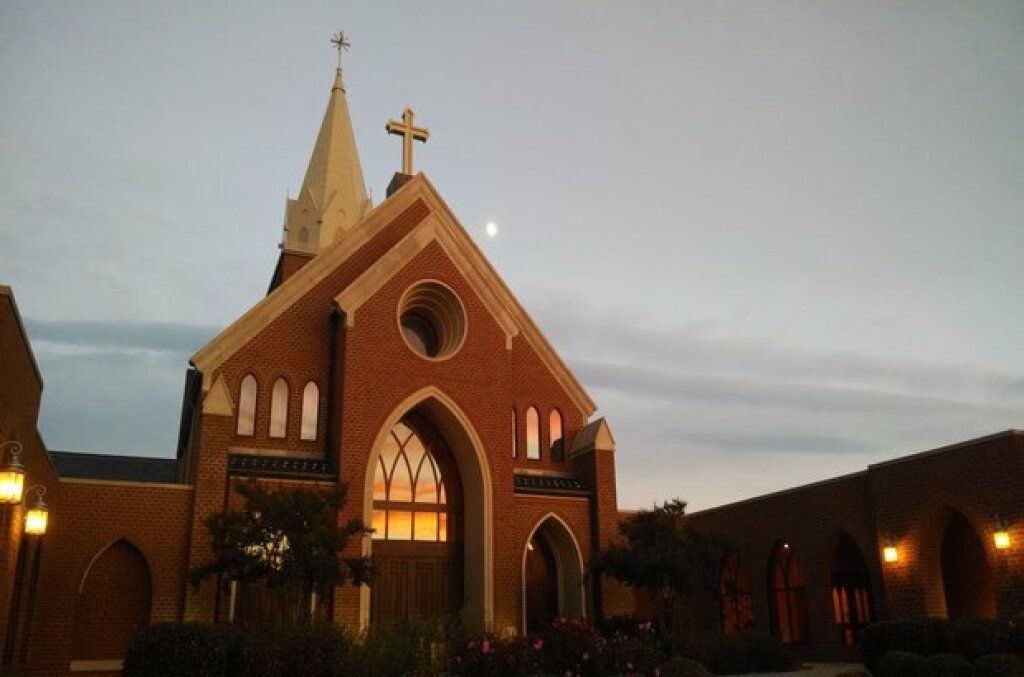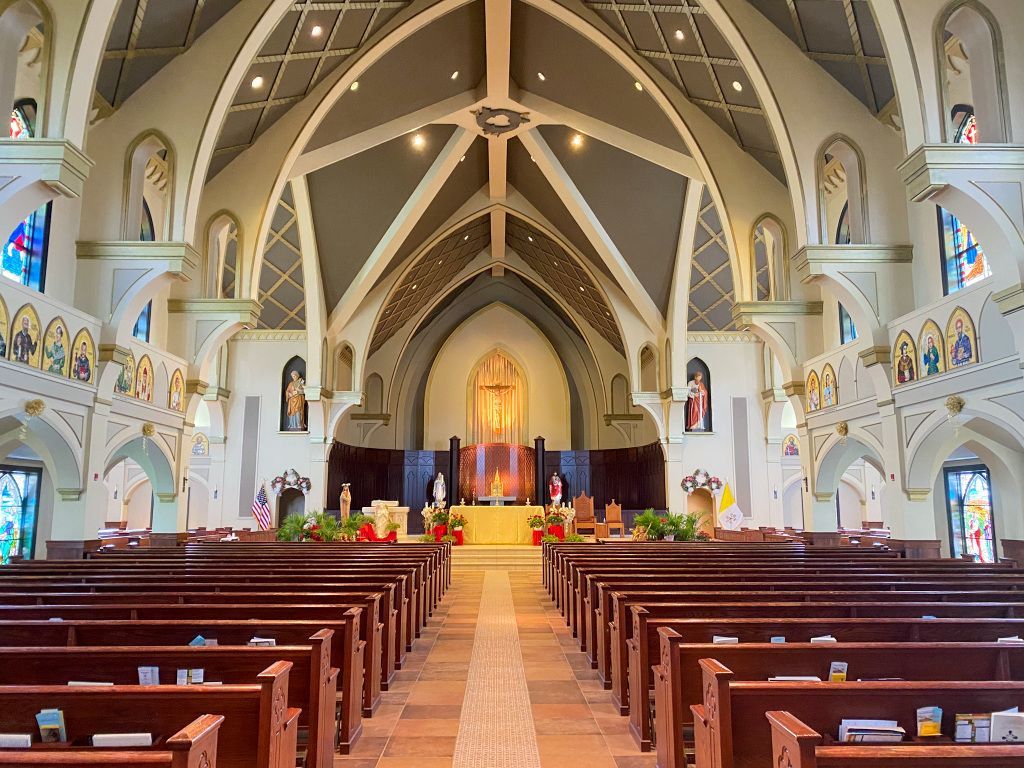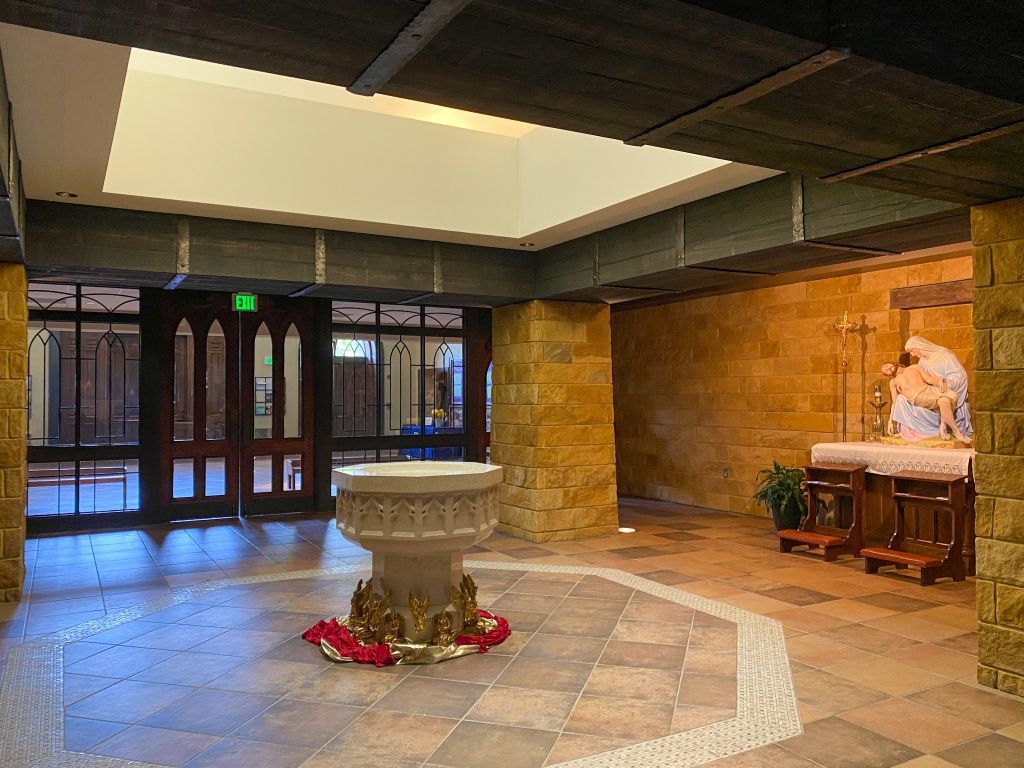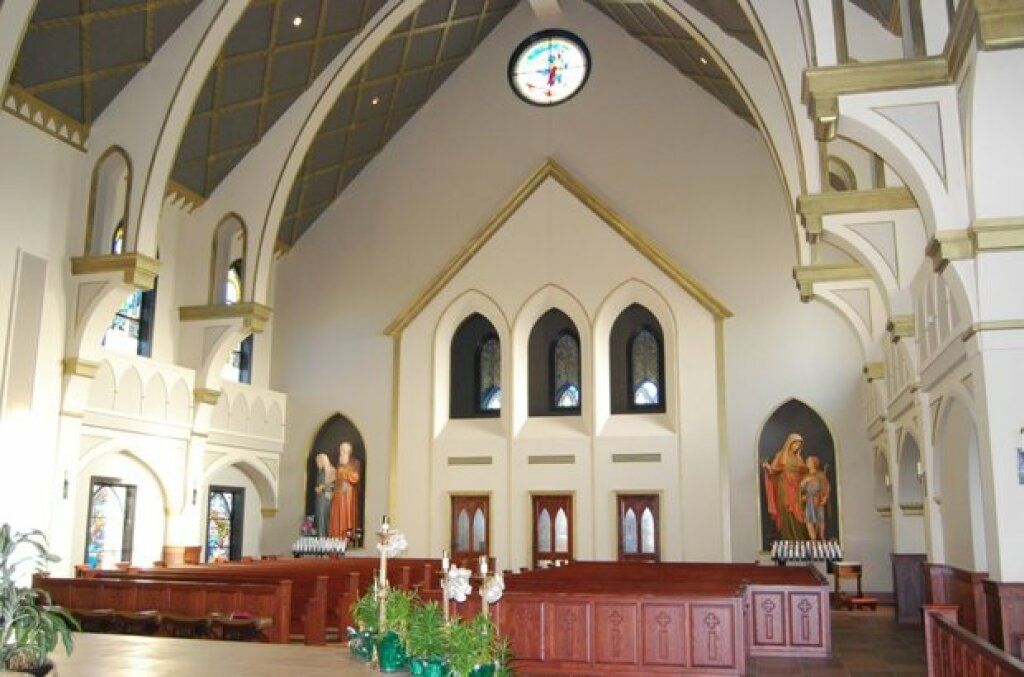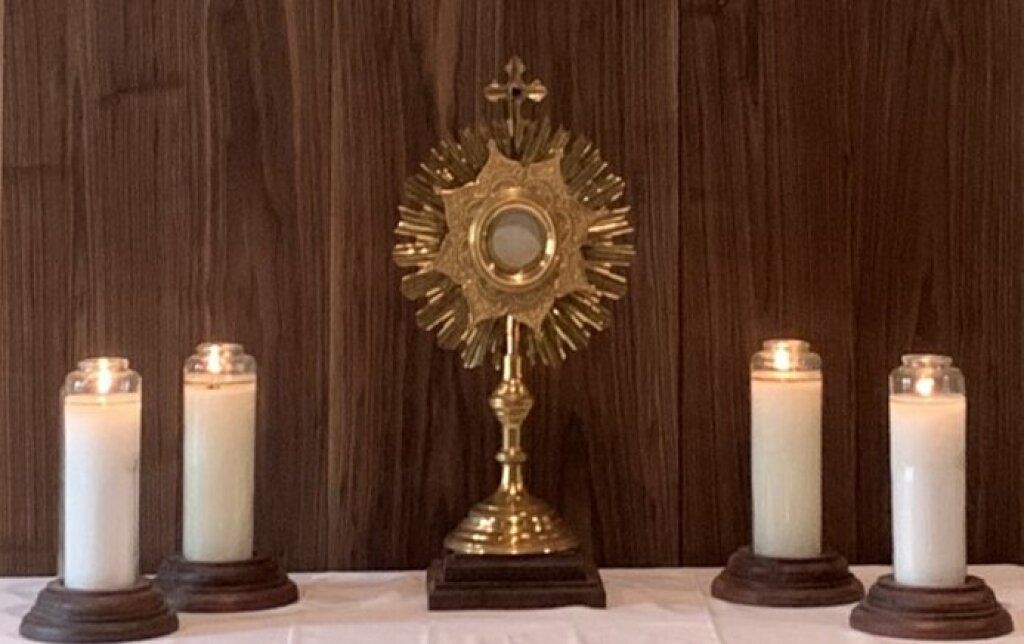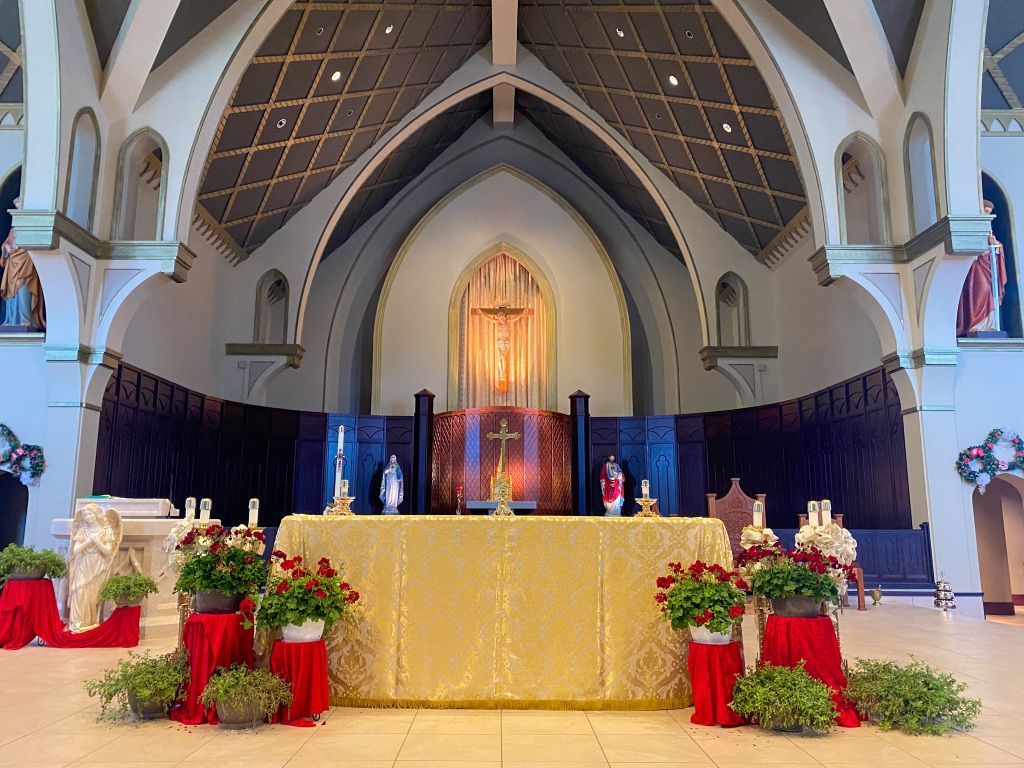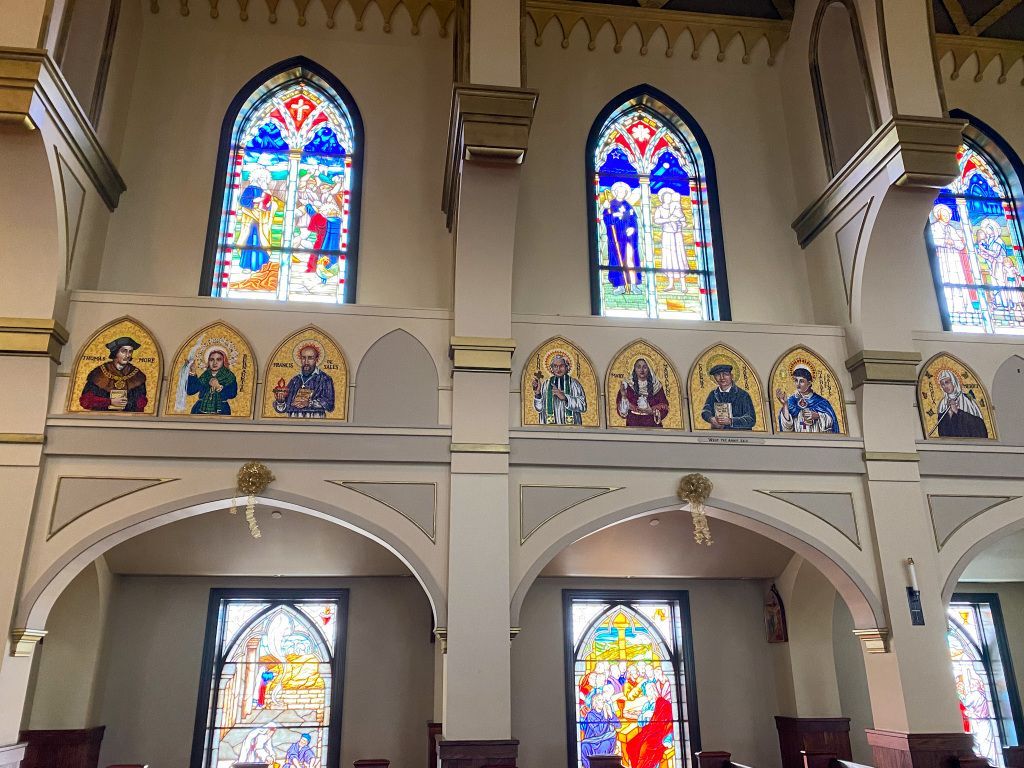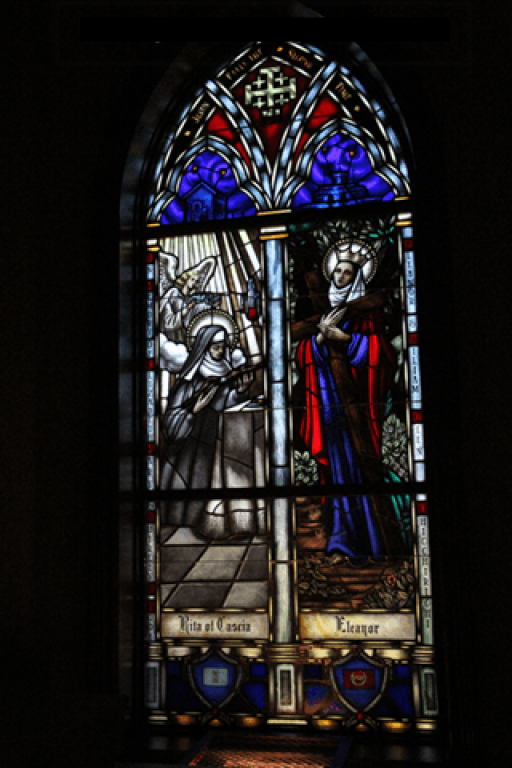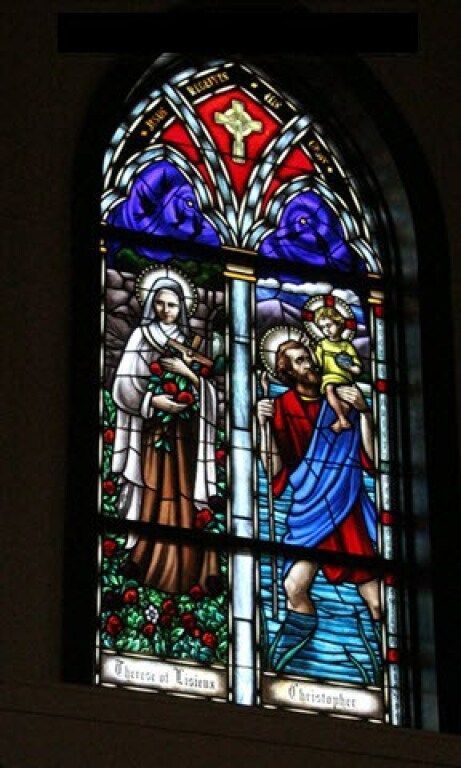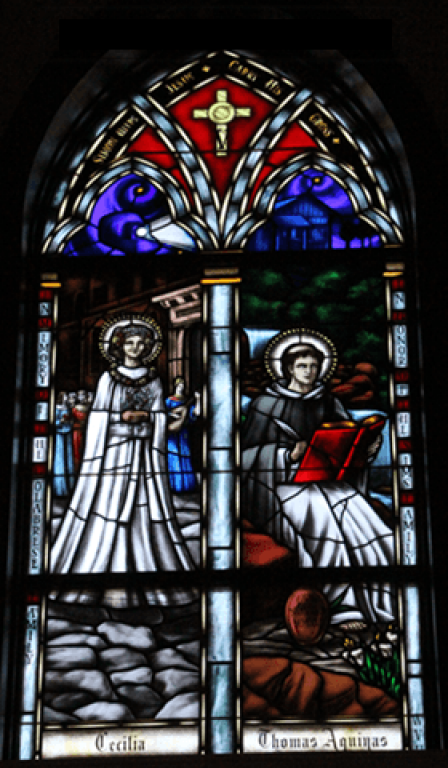Take a Tour
The following explanation of all facets of our church is also available as a PDF here:
Our Church - A Sacred Space
The parish church of St. James the Greater sits just outside the town of Charles Town, partly surrounded by open fields. Similar to the setting of many of the medieval Gothic cathedrals, it dominates the landscape and its bells and carillon ring out over the countryside, calling people to worship and to prayer. Its steeple is capped by an omni-directional cross so that it is plainly seen as a cross from any direction. Additionally, an X is imposed upon the cross as a symbol of Christ, X being the first letter in the Greek spelling of Christos.
Catholic churches are consecrated or dedicated to the glory of God, usually under the patronage of a saint; e.g., St. James, or by a title of a mystery of the Faith; e.g. The Incarnation or The Holy Trinity. St. James is named after James, son of Zebedee, and brother of John. He is known as the “greater” (meaning “older”) so as to distinguish him from the other Apostle James, the son of Alpheus, who is referred to as James the Less.
The scallop shell (seen throughout the church) is the most frequently used symbol of St. James the Greater. Today, the relics of St. James are located in a city of Spain called Santiago de Compostela which used to lie near the sea coast. When pilgrims would travel to visit the relics, they would take home a scallop shell as a momento of their pilgrimage. Over time, this shell would become the symbol of St. James the Greater. The shell was frequently used as a utensil for pouring water at Baptism. Others symbols include the St. James Cross (looks somewhat like a dagger) and the pilgrim’s walking stick and wallet. Our church is Gothic in style (note, the pointed arches), but updated in some aspects (the artistic design of the stained glass windows is more modern in style). Our Pastor refers to it as “West Virginia Gothic.”
The floor plan of the church is the traditional cruciform style of a Latin cross. The traditional “geography” of the church was followed; i.e., the altar is situated in the east, the main entrance in the west, and the ambo (lectern) in the north. When we sit in church we face east towards Jerusalem where we await the Second Coming of Christ and the rising of the sun. The west is where the great rose window (the circular window on the front of the church) was located so that light would shine upon “those who sat in darkness and the shadow of death” (cf., Isaiah). The north was where the barbarians lived and to whom the Gospel was to be proclaimed. The epistle used to be read facing to the south, to those who basked in the light of faith.
Approaching the entrance, you will observe the covered walkways (called a cloister walk) on both the north and south sides of the church. This part of the structure houses the library and offices of the parish.
The Narthex
Once inside the doors of the church, you enter the narthex. This is a gathering space that allows parishioners to meet and greet before and after Mass in the church. It can also be used as a cry room since a glass wall separates it from the sanctuary of the church and the sound system allows people in the narthex to hear the services being conducted in the church.
A recurring theme in the church is that of pilgrimage. At some point in the future, the east wall of the narthex will be decorated with a bas-relief of the pilgrimage to Santiago de Compostela, which was at one time the third greatest pilgrimage site in the Western world.
The windows in the narthex echo the style of the windows in the old St. James Church, which are now beautifully preserved and illuminate the downstairs hallway. The symbols in the narthex windows represent each of the Twelve Apostles upon whom the foundation of the Church rests. The symbols may represent the way the apostles were martyred or an object particularly identified with the apostle, such as the scallop shell for St. James the Greater. In order, facing the main door, from right to left, they are:
St. Peter (the inverted cross and the Keys to the Kingdom of Heaven)
St. Andrew (the saltire “X” cross upon which he was crucified)
St. James the Greater (the scallop shell)
St. John (a chalice with a snake)
St. Philip (a cross and two round loaves of bread)
St. James the Less (a fuller’s—cloth dyer’s club)
St. Thomas (a spear and carpenter’s square)
St. Bartholomew (a flaying knife)
St. Matthew (a money bag)
St. Simon the Zealot (a saw)
St. Jude (a ship)
St. Matthias (an axe)
The center, round window, called an oculus or eye of the church, depicts the Holy Spirit in the form of a dove and His seven-fold gifts of wisdom, understanding, counsel, fortitude, knowledge, piety, and fear of the Lord, illustrated as tongues of fire.
The Baptismal Font and Baptistery
Baptism is the first of the seven sacraments of the Church. It is also known as the gate to the other six. So, as we enter the nave of the church we do so by reminding ourselves that we entered the Church at our baptism.
The font was carved from Botticino marble in Italy and is decorated with the same tracery pattern that you will see on the altar, a Gothic representation of a lighted candle. Its octagonal form recalls the number of people saved in the Ark and the Resurrection on the first day of the week after the events of Holy Week. Also, seven was a perfect number to the Hebrews made into ultimate perfection by adding one: the Messiah—Christ.
It rests upon dark brown ceramic tiles reminding us that we, like Adam, are created from dust. The darkness of the surrounding walls and columns reminds us of the womb from which we emerged into the light of the world. The light evokes the birth into the world and into grace. This contrast also reflects the theological belief that grace builds upon our human nature.
A band of white ceramic tiles surrounds the font, and then goes down the center aisle to the altar to symbolize that by Baptism, we are cleansed of original sin and are able to receive the Eucharist, as celebrated on the altar. In addition, the same path of white tiles runs from the confessionals in each transept to the altar to represent the renewal of our Baptism by the reception of the Sacrament of Reconciliation.
The ceiling of the tower depicts the Holy Spirit hovering over the waters of Baptism as He did over the waters of creation. The opening words of both Genesis and the Gospel of John are recalled in Hebrew, Greek, Latin, and English. It is the Spirit which hovered over the waters of creation that gives rise to our “new beginning” through Baptism. The four-sided tracery is known as a “quatrefoil” which is found in many Gothic churches. The four expanding sides represent the proclamation by Jesus to go out and baptize to the ends of the earth. This tracery is also found on the pews and in the candle stands.
The Ambry, the lighted recess in the wall behind the glass doors, contains the three blessed oils used in the celebration of some of the sacraments. They are Oil of Catechumens, Oil of the Sick, and Sacred Chrism. A traditional Greek icon adorns the opposite wall. It was hand painted by a monk at Mont Athos in Greece. It depicts the baptism of Jesus by St. John the Baptist.
Near the font stands the Paschal Candle, the largest candle in the church. It represents Jesus as the light of the world. From its light the candles of the newly baptized are lighted throughout the year.
Now let us move forward to the sanctuary.
The Sanctuary
The focal point of all Catholic Churches is the Altar of Sacrifice, which represents Christ. It is here that the saving effects of the sacrifice of Jesus on the cross are made present every time the Mass is celebrated. Like the baptismal font, it is made of Botticino marble and was carved in Italy. It is reminiscent of the ancient martyrium or tomb of a martyr. In this case the tracery encloses a memorial of St. James the Greater, martyr, made of red marble from France.
In the mensa or top of the altar there is a relic, a bone fragment of St. James, which was given to the parish by the Shrine of Santiago in Compostela, Spain—the traditional resting place of the Apostle. In addition, the mensa stone contains a relic of St. Faustina and the original relics from old St. James Church.
Closely related to the Altar of Sacrifice is the Altar of Repose where the Blessed Sacrament (hosts consecrated at Mass but not distributed) is kept to be taken to the sick or for personal prayer in the real abiding presence of Jesus. Here, there is no altar but a plinth on which the tabernacle rests. The tabernacle recalls the tent constructed by the Israelites to house the Ark of the Covenant—God’s presence in the midst of His people. This tabernacle mimics the structure of this church. It was created in Italy from carved wood and gold plating.
The sanctuary candle, always lit, stands by it to announce that Christ is present within. Because of the relationship between the bloody sacrifice of Jesus at Calvary and the unbloody sacrifice of the Altar, a crucifix is always found near the altar. Carved in Italy, our crucifix reflects one that was done by the Spanish painter Velasquez. The titulus or signboard over Christ’s head was extensively researched by a member of the parish, William Schweitzer. It is inscribed with the full charge in the three official languages of Jerusalem at the time of the crucifixion; Hebrew, Greek, and Latin: Jesus of Nazareth King of the Jews.
Above the altar, in the ceiling, at the conjunction of the four arms of the cross is a boss, which is a decorative architectural feature of Gothic structures hiding this meeting point. The design is of three fish making a triangle, the primary symbolism of the Trinity. A secondary symbol is that of the Apostles as being “fishers of men” (note, the fishnet design of the ceiling and tops of the walls). The shape of the ceiling of the nave (which is Latin for ship) appears to be an upturned boat.
The Presider’s Chair, in addition to the chairs for the deacons, the statues and wall plaques, were carved in Peru. The back of the Presider’s chair depicts the Chair of Moses, the site of teaching in the synagogue. The backs of all of the chairs have a carving of a candle to represent that we all are called to bear the light of Christ.
The Stations of the Cross have been placed along the arches on the north and south passageways of the nave. They were carved and painted in Peru, as were all the statues in the church. The statues and other carvings in the church were acquired through the Artesanal Cooperative Don Bosco of Chacas. The cooperative is an outgrowth of an apprenticeship program that allows young children from the poorest families to participate in a 5-year apprenticeship program to learn carpentry and woodworking skills. Upon completion of their training, many of the young join the cooperative and produce magnificent artwork as are seen throughout our church.
The Stained Glass Windows
The architecture of Gothic churches allows for the existence of many windows, thus allowing for a characteristic luminosity. The Gothic cathedral, with its large stained glass windows, is a symbol of the divine presence on earth.
The themes for the lower windows in the nave are a response to Pope John Paul II’s Year of the Eucharist. Beginning in the north transept, the windows invite us to make a pilgrimage through the Scriptures. The journey begins with the first recorded sacrifices by Cain and Abel, and ends with the ordained elder at the Church in Corinth celebrating the Eucharist as St. Paul’s instructions are read to him.
Stained glass windows were, and still are, designed to tell the great stories of the Bible to the faithful. Symbolism was frequently used to provide layers of information so the artwork could be visually interpreted or read. It is this traditional symbolism that allows us to identify St. Paul with his sword from St. Peter with his keys. To more fully understand the stained glass windows and the scenes they depict, we recommend reading the scripture verses listed.
It is important to note that the triangular corners at the top of the stained glass windows have symbols or images that help explain the story in the main portion of that particular window. These corners are called “kites”.
The Sacrifice of Abel (Genesis 4:1-6) The right kite shows an eaten apple, a symbol of the fruit of the Tree of the Knowledge of Good and Evil. In the hand of Adam, it becomes a symbol of man’s disobedience. The left kite shows the flaming sword to keep Adam and Eve from returning to Garden after their expulsion.
The Sacrifice of Noah (Genesis 8:20-22) The right kite shows the carpenter’s tools used to build the ark. The left kite recalls the dove that returned with an olive branch announcing that the Flood had begun to recede.
Melchizedek and Abram (Genesis 14:17-20) Melchizedek greets Abram and some of his men after his defeat of the army of the four kings. He offers bread and wine to the most high God and blesses Abram. The right kite depicts a ziggurat or stepped temple and represents Ur, the birth place of Abram and his non-Hebrew origins. It is in modern day Iraq. The left kite represents Melchizedek, king of justice (scales) and king of peace (olive branch).
The Sacrifice of Isaac (Genesis 22:1-18) In the right kite, the Hebrew letter aleph and star represent Abraham, with descendents as numerous as the stars. The left kite’s two bundles of sticks in the shape of a cross symbolize Isaac, who, like Jesus, carried the wood for his own immolation or sacrifice.
The Passover Meal (Exodus 12:1-30) You will note in the background that someone is marking the post and lintels of the door with lamb’s blood so that the Angel of Death would pass over this household. The right kite represents the Burning Bush. The left kite displays the crook and flail, symbols of Pharaoh’s might.
Manna in the Wilderness (Exodus:16:1-36) The woman in the foreground appears to be asking Moses, “What is this?” (Man ‘nu, in Hebrew) The right kite recalls God’s response to Moses’ supplication for water to drink in the desert. The left kite recalls the story of the Brazen Serpent.
The Blood of the Covenant (Exodus 24:3-8) Moses sprinkles the Israelites with blood from the sacrifice, thus sealing the covenant. The right kite has the stone tablets bearing the Ten Commandments. The left kite shows the Apis Bull, a god of Egypt, similar to the golden calf created by the Israelites.
The Ark of the Covenant (Exodus 25:1—30:38) Moses directs construction according to plans revealed to him by God on Mt. Sinai, The right kite has a menorah, which was used to count the days of the week until the Sabbath. The left kite displays the High Priest’s breastplate, which represents the Twelve Tribes of Jacob.
Elijah and Food for the Journey (1 Kings19:1-8) The prophet Elijah, fleeing for his life, sits under a tree and wants to die. God sends an angel with bread and water to strengthen him so that he might continue his journey to Horeb. The right kite shows an empty chair, the Elijah chair. The left kite shows a fiery chariot for Elijah.
An Expiatory Sacrifice (2 Maccabees 12:38-46) Judas Maccabeus holds a broken pagan amulet, which several of his men had worn in disobedience of God’s command. He sends chests filled with drachmas to Jerusalem, so that the priests might offer expiatory (atonement) sacrifices on behalf of the dead, disobedient soldiers. The right kite has the Hanukkah menorah linked to the rededication of the Temple after the profanation by King Antiochus Epiphanes. The left kite shows a dove escaping its cage, an ancient symbol of the soul escaping and flying Heavenward. In this sense it evokes a soul freed from Purgatory.
Thy Will Be Done (Luke 1:26-38) This window is located in the choir loft. The Annunciation forms the bridge between the Old and New Covenants. There is an ancient tradition that the Archangel Gabriel first appeared to Mary at the well in Nazareth. This setting was chosen for this window, which is above the Baptismal Font, because it shows how Christ is brought to us through the waters of Baptism. The right kite contains a symbol of the Immaculate Conception drawn from the Book of Revelation. The left kite is a heraldic shield for St. Cyril of Alexandria, who defended Mary as Theotokos or God-bearer. This is the largest stained glass window in the church.
The Nativity (Luke 2:1-21) The right kite shows a unicorn which, because of its purity, has become a symbol of the Incarnation. Only a virgin could tame a unicorn. The left kite gives another symbol of the Incarnation, the Glastonbury thorn, a bush which blooms twice a year at Christmas and Easter time.
The Multiplication of Loaves and Fish (Matthew 14:13-21) The right kite depicting the mosaic is found in the church of the Multiplication at Tabgha, Israel. The left kite’s eight-pointed star is a symbol of the Beatitudes.
Will You Leave Me, Too? (John 6:22-71) This scene takes place after Jesus teaches that we must eat His Body and drink His Blood. The right kite has a cup marked with a Chi (X) Rho (P) emphasizing “My Blood is real drink.” The left kite shows a communion host marked with a Greek cross and Jesus (IC) Christ (XC) conquers (Nika), emphasizing “My Flesh is real food.”
The Last Supper (Mark 14:12-26) The right kite has a ewer, bowl, and towel recalling the washing of the Apostles’ feet by Jesus. The left kite depicts a pelican which, according to legend, would prick its own breast to feed its hungry chicks.
Behold the Lamb of God (John 19:1-42) According to the Gospel of John, Jesus was nailed to the cross at the same time that lambs were being slaughtered in the Temple in preparation for the Passover Feast. The Sacred Heart of Jesus in the right kite symbolizes the depth of God’s love for us. The left kite relates two legends: the red-breasted robin caught Christ’s blood on its breast before it fell to the ground, and the dogwood tree that asked God that it never again become large enough for a cross to be fashioned from it.
The Road to Emmaus (Luke 24:13-35 and Pope John Paul II’s Letter for the Year of the Eucharist) This is the story of Emmaus. The right kite is the symbol of the Resurrection that Jesus mentioned in the Gospels, the sign of Jonah as he is spit out of the mouth of the big fish or whale. The left kite has the symbol of the victorious Lamb of God.
The Last Breakfast (John 21:1-19) Jesus entrusts the care of His flock to Peter. The right kite has a bishop’s crosier and sheep. The left kite displays the Papal Tiara and Keys symbolizing the Office of the Successors of St. Peter and the Vicars of Christ on Earth.
The Way (Acts of the Apostles 2:42-47) The four aspects of the Way are shown: the teaching of the Apostles, the Breaking of the Bread (the Eucharistic), prayer, and the communal life. The right kite refers to the Ascension. The left kite depicts a fish, an early, secret symbol for recognition among Christians. The fish is usually rendered as a simple line drawing.
In the Person of Christ (1 Corinthians 11:23-34) St. Paul wrote to the Corinthians what he “had received from the Lord.” The right kite gives a symbol of St. Paul, an open book and sword, which symbolizes his extensive writings and defense of the Faith. The left kite bring us full circle to the intact apple in the pierced hand of Jesus symbolizing His fidelity to His Father’s plan for salvation.
The Transepts
In a cruciform-style church, the parts that cross at right angles to the greatest length between the nave and apse are called the transepts. Our confessionals are located in the transepts. In our church, the windows in the north and south transepts have three themes: sin and forgiveness, virtues and vices, and some of the beatified servants of God.
The North Transept
The Round Window: the Archangel Raphael (the divine healer).
The Left Window: Moving clockwise from the top center, the symbols represent the Sacred Heart (center kite), Blessed Maria Elizabeth Hasselblad (upper right lancet), Cardinal Virtues of Fortitude and Justice which overcome the vices of envy and sloth (lower right lancet), the Cardinal Virtues of Temperance and Prudence which help overcome the vices of anger and gluttony (lower left lancet), and Blessed Margaret of Castello (upper left).
The Center Window: The Star of Bethlehem (center), Blessed Gomidas Keumurgian (upper right lancet), King David penitent before Nathan the Prophet (lower right lancet), Adam and Eve aware of their disobedience (lower left lancet), and Blessed (now Saint) Peter Faber, S.J. (upper left lancet).
The Right Window: The standard of the Resurrection (center), Blessed Miguel Pro, S.J; (upper right lancet), King David and Bathsheba the wife of Uriah the Hittite (lower right lancet), the disobedience of Adam and Eve (lower left lancet), and Blessed (now Saint) André Bessette, C.SS.R. (upper left lancet).
The Statuary: Northeast, Joseph and Mary, pregnant with the unborn Christ Child; Northwest, Saint Agatha and Saint Peregrine (cancer sufferers).
The South Transept
The Round Window: The Archangel Michael (meaning Who is as God?).
The Left Window: The Holy Spirit (center), Blessed (now Saint) Marianne Cope, O.S.F. (upper right lancet), denial of Jesus by St. Peter in the courtyard of the High Priest (lower right lancet), betrayal of Jesus by Judas in the Garden of Gethsemane (lower left lancet), and Blessed (Saint) Damien de Veuster (upper left lancet).
The Center Window: A chalice (center kite), Blessed (now Saint) Kateri Tekakwitha (upper right lancet), Jesus and the woman caught in adultery (lower right lancet), the Good Shepherd from the Catacombs in Rome (lower left lancet), and Blessed Junípero Serra, O.F.M (upper left lancet).
The Right Window: A Latin cross (center kite), Blessed Francis Xavier Seelos, C.SS.R. (upper right lancet), Charity which helps us overcome the sin of Lust (lower right lancet), Faith and Hope which help overcome the sins of Pride and Greed (lower left lancet), and Blessed Theodore Guerin, D.C. (upper left lancet).
The Statuary: Southwest niche, Saint Monica and Saint Augustine as a youth, (persistence in prayer); Southeast, Saint Joachim and Saint Ann, the aged parents of the Blessed Virgin Mary as well as grandparents of Jesus.
The Clerestory Windows
The upper windows of the nave will depict some of our saints. In these we will see a fraction of that “great cloud of witnesses” from the Letter to the Hebrews, urging us on to finish the race:
St. Patrick (Ireland)
St. Francis of Assisi (Environment and Peace)
St. Christopher (Travelers)
St. Margaret Mary (Sacred Heart)
St. Anthony (Lost Things)
St. Benedict (Against Temptations)
St. Clare (Public Relations)
St. Faustina (Divine Mercy)
St. Brendon (Sailors and Those at Sea)
St. Therese of Lisieux (Florists and Missionaries)
St. Robert Bellarmine (Catechists and Teachers)
St. Valentine (Love)
St. Martin de Porres (Those Suffering Discrimination)
St. Stephen, Deacon and Martyr (Deacons)
St. Nicholas (Children)
St. Lucy (Eyes)
St. Maximilian Kolbe (Political Prisoners)
St. Thomas More (Lawyers and Those in Political Life)
St. Elizabeth Ann Seton (Mothers and Teachers)
St. Anne (Grandmothers)
The Choir Loft & Music Rooms (upstairs)
Niches: The two niches by the stairwells contain Peruvian wood carvings of Our Lady of Antipolo (Filipino) in the southwest niche; and Our Lady of Guadalupe with St. Juan Diego (Mexican) in the northwest niche.
Group Practice Room: a stained glass window depicting an arrangement of ancient musical instruments and a young King David playing the harp and the Star of David with the Tetragrammaton is depicted on the stained glass window.
Music Director’s Room: a piece of Gregorian chant, the coat-of-arms for Pope St. Gregory the Great, and a set of organ pipes in honor of St. Cecilia.
The Organ: The organ is a product of the Allen Organ Company. It is the largest organ built by the Pennsylvania-based company. It is a four-manual, 136 stop digital organ.
The Lower Level
Descending the steps to the lower level, you will pass by the crucifix from the old church which serves as a reminder that Christ unites both past and future generations.
The stained glass windows from the old church are positioned along both sides of the hallway on the lower level. The Marian window, which was located on the front of the old church, is now the centerpiece of the sitting area.
We continue the tradition of honoring our saints by naming our classrooms in their honor. Artwork depicting each saint is displayed in the classrooms, allowing our youngest parishioners an opportunity to learn more about this tradition.
At the east end of the hallway is the social hall which can seat up to 350 persons. A large patio expands the room for larger social gatherings. On the east wall of the social hall is a fireplace over which hangs an impressive Oberammergau crucifix. Flanking the crucifix are wooden carvings of the wedding feast at Cana and the Miracle of the Loaves and Fishes. Both miracles are fitting scenes for a room designed to host celebrations and feasts.
The Sr. Carolyn Ackerman Library
Our library is located on the northwestern corner of the church building on the main level. The library is dedicated to the memory of Sr. Carolyn Ackerman whose large collection of books was the first donation received for our new parish library. The present collection has over 5,000 books available for loan to our parishioners. The library contains a wide variety of books to enhance and stimulate our spiritual and intellectual growth. The library is staffed by a group of volunteers who lovingly catalog and care for our growing collection.
Social Concerns Building
Adjacent to the church is a brick warehouse that provides storage and office space for the various social concerns and outreach ministries of the parish, such as the Webster Springs Project and Gabriel Project. We are exceedingly grateful for the generosity of the Chicchirichi Family who memorialized the construction of this building in honor of Orazio and Maria DiGiacomo Chicchirichi. As stated on the plaque outside the building, “This building is a testament to their example of living the faith of Christ by reaching out to those in need.” Thanks to the continuing generosity of the Chicchirichi family, we will be able to serve the needs of the poor for years to come.
Interesting Facts
St. James is the largest Catholic church in the State of West Virginia and has a seating capacity of 1,200 persons. A total of 350,000 red bricks were used on the exterior. The brick exterior was selected to harmonize with the architecture of historic Charles Town. The building contains 400 tons of structural steel. There are 66,000 pieces of slate on the roof. Over 50,000 feet of wiring was installed by volunteers. There are about 3,500 persons enrolled in the parish at the present time.



